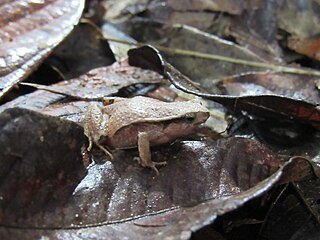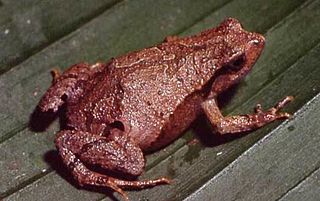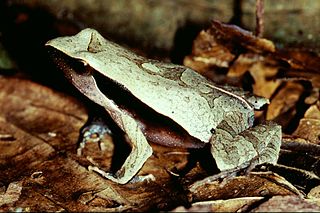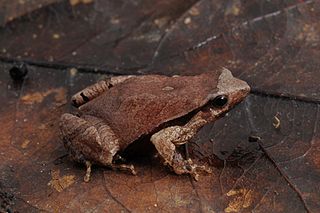Physalaemus aguirrei is a species of frog in the family Leptodactylidae. It is endemic to eastern Brazil and occurs in the southern Bahia, northern Espírito Santo and northeastern Minas Gerais. The specific name aguirrei honours Alvaro Coutinho Aguirre, a Brazilian zoologist. However, common name Linhares dwarf frog has been proposed for it.

Physalaemus biligonigerus is a species of frog in the family Leptodactylidae. It is found in Argentina, Bolivia, Brazil, Paraguay, and Uruguay. Its natural habitats are subtropical or tropical dry forests, temperate shrubland, subtropical or tropical dry shrubland, subtropical or tropical moist shrubland, temperate grassland, subtropical or tropical dry lowland grassland, subtropical or tropical seasonally wet or flooded lowland grassland, freshwater lakes, intermittent freshwater lakes, freshwater marshes, sandy shores, arable land, pastureland, plantations, rural gardens, urban areas, heavily degraded former forest, water storage areas, ponds, irrigated land, seasonally flooded agricultural land, and canals and ditches.

Physalaemus caete is a species of frog in the family Leptodactylidae. It is endemic to Brazil. Its natural habitats are subtropical or tropical moist lowland forests and intermittent freshwater marshes. It is threatened by habitat loss.

Physalaemus centralis is a species of frog in the family Leptodactylidae. It is found in Bolivia, Brazil, and Paraguay. Its natural habitats are moist savanna, subtropical or tropical moist shrubland, subtropical or tropical seasonally wet or flooded lowland grassland, freshwater marshes, and intermittent freshwater marshes. It is threatened by habitat loss.

Physalaemus cicada is a species of frog in the family Leptodactylidae. It is endemic to Brazil. Its natural habitats are dry savanna, moist savanna, and intermittent freshwater marshes. It is threatened by habitat loss.

Physalaemus crombiei is a species of frog in the family Leptodactylidae. It is endemic to Brazil. Its natural habitats are subtropical or tropical moist lowland forests and intermittent freshwater marshes. It is threatened by habitat loss.

Physalaemus cuvieri is a species of frog in the family Leptodactylidae. It is found in Argentina, Brazil, Paraguay, and possibly also Bolivia, Guyana, Uruguay, and Venezuela. Its natural habitats are subtropical or tropical moist lowland forests, moist savanna, subtropical or tropical dry lowland grassland, subtropical or tropical seasonally wet or flooded lowland grassland, intermittent freshwater lakes, intermittent freshwater marshes, arable land, pastureland, plantations, rural gardens, urban areas, heavily degraded former forest, ponds, irrigated land, seasonally flooded agricultural land, and canals and ditches. It is threatened by habitat loss.
Physalaemus erythros is a species of frog in the family Leptodactylidae. It is endemic to Brazil. Its natural habitats are subtropical or tropical moist shrubland, subtropical or tropical high-altitude grassland, intermittent freshwater marshes, and rocky areas. It is threatened by habitat loss.
Physalaemus evangelistai is a species of frog in the family Leptodactylidae. It is endemic to Brazil. Its natural habitats are subtropical or tropical moist shrubland, subtropical or tropical seasonally wet or flooded lowland grassland, swamps, and intermittent freshwater marshes. It is threatened by habitat loss.

Physalaemus fernandezae is a species of frog in the family Leptodactylidae. It is found in Argentina, Uruguay, and possibly Brazil. Its natural habitats are subtropical or tropical seasonally wet or flooded lowland grassland, intermittent freshwater marshes, and rocky areas. It is threatened by habitat loss.

Physalaemus kroyeri is a species of frog in the family Leptodactylidae. It is endemic to northeastern Brazil.

Physalaemus lisei is a species of frog in the family Leptodactylidae. It is endemic to Brazil. Its natural habitats are subtropical or tropical moist lowland forests, moist savanna, and intermittent freshwater marshes. It is threatened by habitat loss.
Physalaemus maximus is a species of frog in the family Leptodactylidae. It is endemic to Brazil. Its natural habitats are subtropical or tropical moist montane forests, swamps, and intermittent freshwater marshes. It is threatened by habitat loss.

Physalaemus moreirae is a species of frog in the family Leptodactylidae. It is endemic to the Serra do Mar in the São Paulo state, Brazil.

Physalaemus nanus is a species of frog in the family Leptodactylidae. It is endemic to Brazil. Its natural habitats are subtropical or tropical moist lowland forests, intermittent freshwater marshes, rural gardens, heavily degraded former forest, irrigated land, seasonally flooded agricultural land, and canals and ditches. It is threatened by habitat loss.

Physalaemus olfersii is a species of frog in the family Leptodactylidae. It is endemic to southeastern Brazil and is known from Espírito Santo, southeastern Minas Gerais, and São Paulo states. Records further south refer to Physalaemus lateristriga, which was restored from the synonymy of Physalaemus olfersii in 2010. Common name Atlantic Forest dwarf frog has been proposed for this species.
Physalaemus rupestris is a species of frog in the family Leptodactylidae. It is endemic to Brazil. Its natural habitats are subtropical or tropical moist montane forests and intermittent rivers. It is threatened by habitat loss.
Physalaemus santafecinus is a species of frog in the family Leptodactylidae. It is found in Argentina and possibly Paraguay. Its natural habitats are temperate grassland, intermittent freshwater lakes, intermittent freshwater marshes, and pastureland. It is threatened by habitat loss.

Physalaemus signifer is a species of frog in the family Leptodactylidae. It is endemic to Brazil. Its natural habitats are subtropical or tropical moist lowland forests, dry savanna, freshwater marshes, and intermittent freshwater marshes. It is threatened by habitat loss.
Physalaemus soaresi is a species of frog in the family Leptodactylidae. It is endemic to southeastern Brazil where it is only known from three localities in the Rio de Janeiro state, one of them lost to urbanization and habitat degradation.














